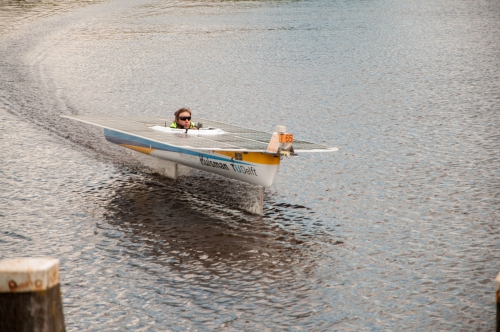Hydrofoil Engineering
A year in the TU Delft Solar Boat Team 2014 has brought me to the field of hydrofoil design. With these "wings for a boat", it is possible to lift the hull of a lightweight, fast vessel out of the water. This can reduce the power consumption with more than 60%. The unique dynamic characteristics of hydrofoil craft remain a fascinating subject on which I did some work.
TU Delft Solar Boat 2014
In August 2013, after my second year of studying Aerospace Engineering, I became a full-time team member of the TU Delft Solar Boat Team. With this team, we designed and built the first single-track hydrofoil solar boat of our competition. A single-track boat uses two submerged wings in-line that lift the hull of the boat out of the water. Although the aluminium foils suffered from "air ventilation" sometimes, the concept worked. It was a big effort to get the boat flying in a stable way, but we learned a lot of lessons from it that we took to Flying Fish. Check out the "Dagverslag" (day report) video of one of our competition days to see the boat in flying action!

Images and videos © Screen Visuals

Screen capture from the real-time hydrofoil flight simulator that I developed after our validated dynamics research with Johan. The current version also supports wind and wave effects.
Hydrofoil "bicycle dynamics" validation
In 2015, our successors in the TU Delft Solar Boat Team desired to use the single-track hydrofoil concept again. This time, as members of the technical advisory committee, Johan Schonebaum and I modelled the dynamic behaviour of the boat to find the optimum strut length, flight height and distance between the two hydrofoils. This model was based on conventional aircraft flight dynamics and bicycle dynamics. We validated the model in the real world with cooperation of the Solar Boat Team 2016. With our publication on this research, we won the International Hydrofoil Society's Mandles Prize 2017. Read all technical stuff about this research at the Flying Fish website. A news article is found at the TU Delft website. If you want to dive right into it, download the full article here.
Awards and follow-up research
The research we did at the Solar Boat Team was supported by the entire team and TU Delft staff. I especially want to thank Johan Schonebaum, Dr. Arend Schwab, Thore Roepman, Casper Vertregt, Jodi Kooijman, Luc Does, Bart Vonk and Gijs Bruining.
Because of the novelty of hydrofoil dynamics research to the Dutch maritime sector, I received the Maritime Designer Award in 2018. Together with Johan, I was inspired to start Flying Fish after graduating.
With the knowledge gained from this research, we are currently developing the HOST (Hydrofoil Optimization and Simulation Tool) at Flying Fish. This real-time 3D simulator is a very valuable tool in optimizing hydrofoil dynamics and control under all sorts of weather and loading conditions!

Winning the Maritime Designer of the Year award at Dutch Maritime Awards Gala in 2018.